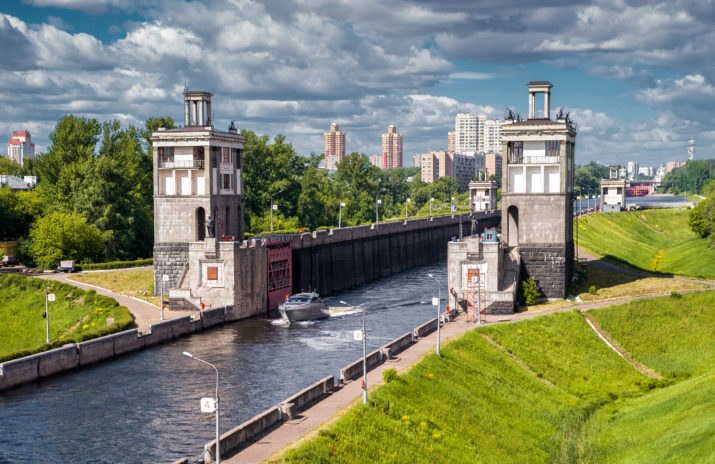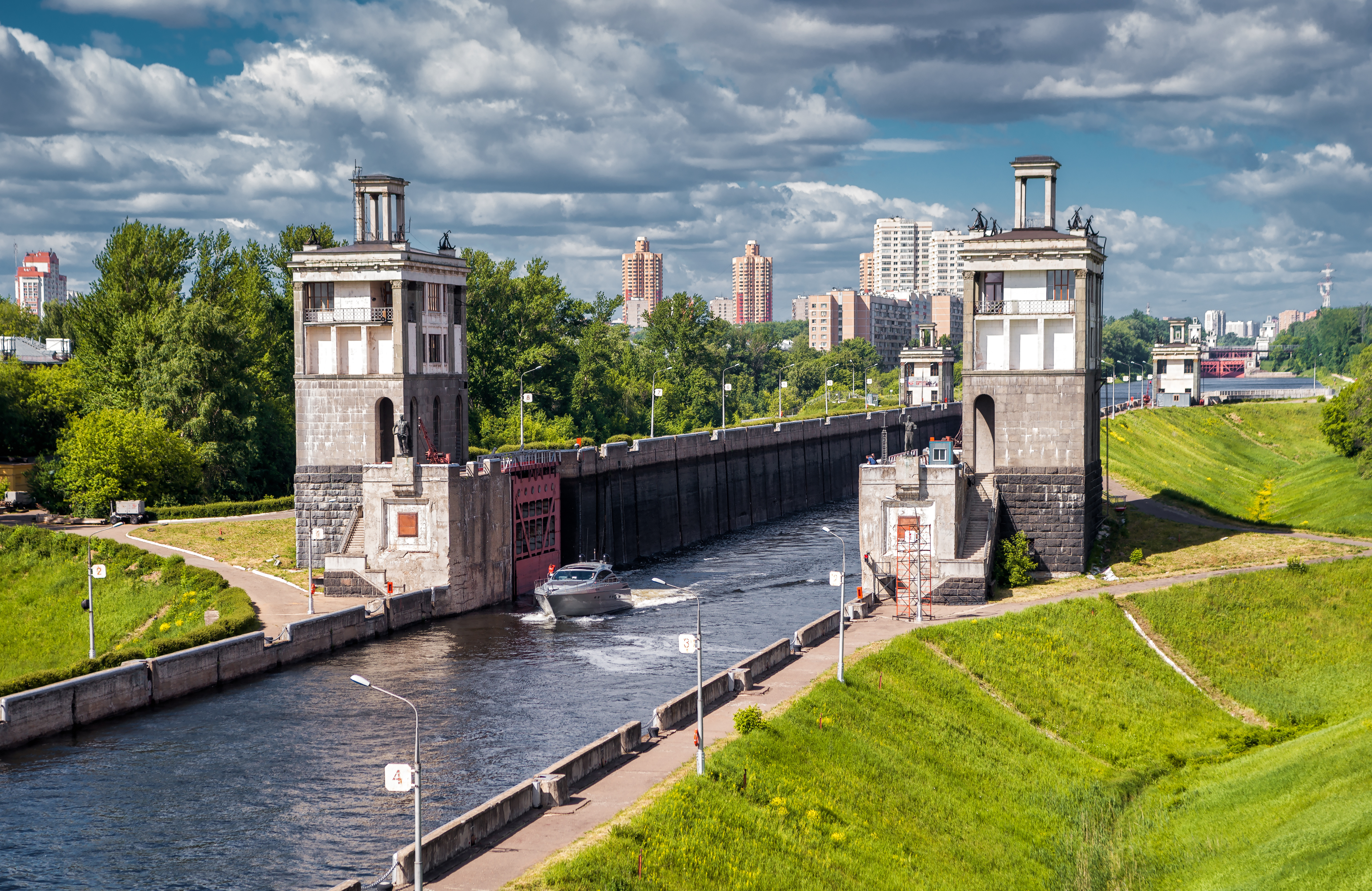

This is part of our special feature on Water in Europe and the World.
Hydro-technical projects were among the most celebrated construction ventures undertaken during Stalinism. While numerous dams, reservoirs, power stations, and the like were built, the three large canals in European Russia—foremost among them the Stalin White Sea-Baltic Canal [more commonly known as the Belomor Canal], the Moscow-Volga Canal, [called the Moscow Canal since 1947], and the Volga-Don Canal [completed only after WWII]—remain the most well-known and visible. These waterways, along with the quickly constructed Fergana Canal in Central Asia (1939), illustrate the physical manifestation of Stalinist ideology, which created both real and imagined spaces that evoked key elements of the Stalinist program.[1] In doing so, these projects physically built Stalinism just as powerfully as any collective farm, industrial complex, or skyscraper could. Indeed, these canals continue to remind us of the Stalinist legacy and its excesses, foremost among them the use of Gulag forced labor to construct enormous waterways that, in spite of primitive building tools and great loss of life, continue to provide transportation corridors, potable water, recreational areas, and electric power for millions of Russian citizens. While an exhaustive analysis of these three Canals remains beyond the purview here, this article illuminates the highlights of these canals’ shared history as evidence of the political ideology they engendered.
The history that the Belomor, Moscow, and Volga-Don canals share grew out of their common pedigree as NKVD-supervised construction sites in the Gulag economy—a system that by its very nature demanded large infusions of human capital in order to complete its projects. At the behest of the Soviet People’s Commissars of the USSR, the NKVD established camps to undertake canal construction: the Belomorsko-Baltiiskii ITL (1931-1941), Dmitlag (1932-1938), and Volgadonstroi ITL (1948-1952).[2] In addition, the canal projects were included in the appropriate five-year plans, thereby situating them within the larger context of the Soviet economy. Lastly, each canal garnered official approbation for the engineering feats achieved with minimal mechanization (especially in the case of Belomor and the Moscow Canal), maximal exploitation of local natural resources, and tightly regulated monetary support.
In terms of their physical attributes, the Belomor, Moscow, and Volga-Don canals share the same principle: they were constructed to connect important waterways not only with each other, but with major urban centers as well. The reasons most frequently supplied for these projects included economic factors—(more efficient transport of goods and raw materials from their points of origin to potential markets); strategic factors—(the desire to provide a system of waterways that would allow the Soviet military to move men and machines in virtually any direction, including to the open seas, in the case of naval blockades in the north or south); and political factors—(the successful construction of the canals underscored the ability of Stalinism to achieve goals that the tsarist regime was incapable of realizing as a consequence of its misguided ideology). Moreover, the European canal system literally and figuratively turned land-locked Moscow into the “port of five seas” thereby securing its position not only as the metaphorical center of the Soviet Union, but also as a world capital to which every body of water ultimately flowed.[3] Finally, the Belomor and Moscow Canal projects (much more than the Volga-Don Canal) served as archetypal events in the development of the Gulag as a parallel economic and social universe charged initially with “reforging” state enemies, yet ultimately responsible for undertaking projects that demanded large labor supplies with little thought to the repercussions of such decisions.
For all their similarities, significant differences exist among the three canal projects, partially as a consequence of the eras that produced them. Whereas the Belomor and Moscow canal projects were redolent with the rhetoric of rapid industrialization, nation-building, and reforging—perekovka—the Volga-Don is less so. Its construction after WWII meant that significantly less attention was devoted to industrialization at any cost with more emphasis on the burgeoning Cold War. Had WWII not interrupted plans for the construction of the Volga-Don Canal, it, too, might have generated the same intense rhetoric devoted to the proposed recasting of state enemies into productive Soviet citizens.
On the other hand, all three projects included enormous contingents of Gulag labor, as the following figures reveal:
Canal Peak Inmate Population
Belomor 119,660 as of 1.04.32
Dmitlag 195,648 as of 1.05.35
Volgadonstroi 133, 193 as of 1.01.52[4]
Over the course of its existence, the Dmitlag was the largest camp in the entire Gulag network. In terms of time, Belomor was constructed in twenty months, the Moscow-Volga in less than five years, and the Volga-Don in four years. In size the canals are comparable, even if we consider that natural waterways and features found along each canal route were included in the finished length of the waterways.
Canal Length Depth Locks
Belomor 227 km. 5 m. 19
Moscow-Volga 128 km. 5.5 m. 11
Volga-Don 101 km. 3.5 m. 13
Locks were not the only structures erected along each Canal route. Most significantly, the Moscow and Volga-Don Canals are replete with hydroelectric plants and water pumping stations that supply the areas bounding the waterways with power and potable water. Each of these stations required an elaborate architectural plan, as did the various dams, reservoir gates, and dikes that populate the Canal routes. Taken as a whole the construction of all three Canals encompassed not only basic waterway construction, but also industrial and architectural structures. The diversity of buildings underscores the talent, ingenuity, resourcefulness and creativity zek engineers and laborers, as well as free workers, brought to each project.
In terms of their monetary cost, expenditures were, in spite of the NKVD’s best efforts, rather high: Belomor—535 million rubles; Moscow-Volga—1 billion 400 million rubles; Volga-Don–1 billion rubles.[5] The economic cost, however, fails to reflect the immense human cost that has yet to be measured, especially considering that a rough tally of the data suggests that over 500,000 prisoners moved through the three canal projects at some point during construction. Indeed, these numbers fail to include inmates’ families who suffered incalculable emotional, financial, and personal losses, a by-product that all three projects share.
Perhaps the most significant difference among the canals remains the level of exploitation each waterway enjoys at present. The Belomor Canal never reached the usage levels projected from its very inception. The canal’s shallow structure and the harsh climate in which it is situated meant that the Belomor was never able to transport the heavy military equipment and large shipments of raw materials intended for the waterway. A 1979 statistic notes that typical yearly traffic on Belomor averaged 6 million tons for a shipping season of roughly 6 months. On the other hand, the Volga-Don in the same period handled 12 million tons of cargo, while the Moscow-Volga handled 17.2 million tons.[6] In addition, the opening of the Kazakh oil fields to foreign firms, as well as the full exploitation of the Baku oil fields, has made the Volga-Don Canal a significant waterway vital for the transport of crude oil and petroleum products. According to statistics cited when the canal celebrated its 50th anniversary, during the 2002 shipping season the Volga-Don Canal handled 2,500 ships carrying a total of 3.7 million tons of cargo. Throughout its history it has handled over 400,000 ships with a total of 350 million tons of cargo.[7] Of course the Volga-Don’s geography supports broader exploitation given the milder climate in which it operates. Even the Moscow Canal suffers from a reduced shipping season because its waters freeze over in winter. Hence, compared to Belomor, the Moscow and Volga-Don canals continue to demonstrate some usefulness, thereby fulfilling part of their legacies.
If we consider the construction of the three European canals as part of the larger program to build a singularly Soviet space, albeit on the backs of slave laborers, then the consequences and subsequent apprehension of the canals remains no less important. Indeed, in building the canals, the Gulag constructed Soviet space both to create and reinforce the relatively new notion of the Soviet Union, as in the Belomor and Moscow canal projects, and to re-emphasize the power and indestructibility of Soviet space, to wit the post WWII Volga-Don Canal. Certainly the construction of all three canals supports this contention for their creation, as well as their subsequent exploitation and reception, manifest how totalitarian ideology, monumentality, and Stalinist cultural/social policies were idealized and realized through the spaces they occupied. Arguably these “Gulag” spaces turned out to be the most “Soviet” spaces of all. Yet how do these spaces directly reflect the Stalinist politics of water?
During the 1930s, the Soviet Union witnessed the robust exploitation and management of many natural resources, among the most important of which was water. Control over a seemingly uncontrollable commodity like water would validate the Stalinist regime’s policies, thereby not only legitimizing the regime’s political agenda, but also physically inscribing into the landscape water projects redolent of the ethos of Stalinist ideology. In the case of the Belomor Canal, harnessing the waters of the Karelian north to provide an escape route for the Soviet Fleet should it face a blockade in the Baltic Sea, embodied the ability of Stalin’s USSR to achieve that which Tsar Peter the Great could not; however, this achievement cut both ways. On the one hand the completion of the Stalin White Sea-Baltic Canal equated the Canal’s namesake with Tsar Peter I who sought to create a Russia equal to, if not stronger than, its Western contemporaries, a goal Stalin shared vis-à-vis industrialization and competition with the capitalist West. Consequently, the Belomor project supposedly elevated Stalin to the ranks of Russia’s great rulers thereby affirming both his power and foresight. On the other hand, Stalin’s system deployed slave labor, much as did Peter the Great, both of whom constructed their political edifices literally on the bones of their builders, a less flattering, but no less true comparison. In Stalin’s case, the Belomor project was the first of many to employ purported political enemies in service to state building. In so doing, the Stalinist government managed to simultaneously complete long-contemplated projects that the Tsarist government could or chose not to realize while demonstrating in the most physical terms the Marxist slogan that “in changing nature man changes himself.” Of course the price that the Soviet government and, more importantly, the Soviet people paid to bring these projects to fruition was a high one—the use of forced labor. Indeed the deployment of forced labor to make real heretofore unrealized projects further demonstrated a key element of Stalinist political thought: Criminal social miscreants and state enemies could be reforged into model, productive Soviet citizens through hard labor and strict discipline.[8]
This was no less true on the Moscow Canal project, conceived as a centerpiece in the development of Moscow as the capital not only of the Soviet, but the Communist empire. In practical terms, the reconstruction of Moscow relied on a steady supply of fresh water and ample electricity. Otherwise, projected skyscrapers and additional infrastructure, such as the Moscow Metro, would enjoy little success if water and power could not be sustained for the burgeoning Soviet metropolis. In addition, the Moscow Canal rerouted part of the mother of Russian rivers, the Volga, in service to the Soviet state, an action that physically and metaphorically emphasized the ability of Soviet power in general and Stalin in particular to command and conquer formerly Russian natural resources. Significantly, the destruction and submersion of old Russian river towns such as Korcheva symbolized the Stalinist regime’s ability to obliterate reminders of the Russian past in order to create the Soviet future.[9] No less important was the establishment of Moscow as a “port of five seas,” thereby bringing the world to the walls of the Kremlin and sending the Kremlin’s message to the rest of the world. No matter that the sobriquet Moscow Port of Five Seas appeared long before it became reality. Moscow remained a port of three seas until the completion of the Volga-Don Canal (initially named after Lenin) when access was finally provided to the Azov and Black Seas. In the world of Stalinist political thought, however, the imagined spaces that the rhetoric created often carried more significance than the real spaces.
Ultimately, the politics of water during pre-WWII Stalinism rested on metaphorical, geographic, and ideological foundations to implement and justify the Belomor and Moscow Canal projects. The metaphorical and ideological spaces that these waterways occupied often carried greater importance than the physical structures and their accompanying landscapes. For example, in calling the Moscow Canal “the greatest structure of the Stalinist epoch” Komsomol leader A.V. Kosarev accentuated the symbolic and quotidian value of the waterway, even if this was not entirely the case.[10] Similarly, naming the Moscow Canal the “port of five seas” an oft-repeated metaphor in the press and publications about the waterway, even before the idea became a reality, carried greater significance: This pre-emptive metaphorical tactic planted the idea of the strength, correctness, and foresight of Stalinist thought thereby creating an imagined space that commanded attention even without the physical space to support it. Likewise, the physical placement of the Belomor (to a lesser degree) and the Moscow (to a greater degree) canals both inscribed the landscape and changed the map of the Stalin’s Soviet Union. The Belomor Canal traversed the rocky, marshy, mosquito infested north, while the Moscow Canal scaled the elevation between the Volga and Moscow while channeling an endless supply of Volga water to the capital thereby ensuring not only its survival, but growth and prosperity. In so doing these waterways conquered spaces thought previously unconquerable due to inhospitable climatic and physical conditions, while visibly carving waterways in areas where they did not formerly exist—in effect Sovietizing the landscape.
Most important Soviet power in its Stalinist incarnation seemed to control the uncontrollable: by harnessing, redirecting, and exploiting the flow of water the regime tapped into the element’s rich imagery and symbolism. For example, the image that most eloquently links the past and present of the Moscow Canal and defines its space most emphatically remains the water that flows through it. The Moscow Canal literally brought life to the center of the country, indeed the center of power, namely the Kremlin. Similarly the Moscow Canal physically and rhetorically joined Moscow not only to the rest of the Soviet Union, but the rest of the world. Just as the Moscow Canal cut through the landscape, it also continues to cut through time and space thus linking the landscape’s past, present, and future. Finally, the contradictions inherent in the metaphor of water persist as well: Water is life affirming and life taking; it simultaneously nourishes and destroys; it is impossible to live without it, yet also impossible to control completely; it can be deceptively calm or blatantly raging. Indeed this list of opposites achieves a certain strange totality not unlike that which defined Soviet space and the politics that shaped it. Vis-à-vis the Moscow Canal, the water was and can be a source of pleasure or the source of great sorrow. No matter how one perceives the water itself though, the landscape that it has, in part, shaped remains a space that helped define the image and reality of Stalinist landscapes and the Soviet Gulag two direct outgrowths of the politics of water during the 1930s.
Cynthia A. Ruder is an Associate Professor of Russian Studies at the University of Kentucky. Her recent book Building Stalinism: The Moscow Canal and the Creation of Soviet Space (2018) argues that the construction of the Moscow Canal physically manifests Stalinist ideology through the landscape that it altered and into which it was inscribed. Her publications include the monograph Making History for Stalin: The Story of the Belomor Canal (1998) and various articles. Her current research focuses on the artists who captured the Moscow Canal on canvas.
References:
[1]For the history of the construction of the Belomor Canal see Cynthia A. Ruder, Making History for Stalin: The Story of the Belomor Canal, Gainesville, FL: University Press of Florida, 1998; on the Moscow Canal, Cynthia A. Ruder, Building Stalinism: The Moscow Canal and the Creation of Soviet Space, London: I.B. Tauris, 2018. For the Volga-Don Canal see http://welcome2018.com/en/cities/volgograd/volgo-donskoy-sudokhodnyy-kanal/ accessed 21 October 2018. Russian sources include N. I. Buslenko, Volga-Don: Sliianie vod. V 5-ti knigakh. Rostov-na-Donu, 2011. Official government web sites include: Belomor http://bbkanal.ru/page2374545.html; Moscow Canal http://kim-online.ru/; and Volga-Don http://www.vdgbu.ru/ all accessed 21 October 2018. Sources on the Fergana Canal include http://soviethistory.msu.edu/1939-2/great-fergana-canal/ and http://www.environmentandsociety.org/tools/keywords/start-construction-great-fergana-canal accessed 14 October 2018.
[2] Stalinskie stroiki Gulaga 1930-1953, 523. Kokurin and Morukov note that a total of 236,778 zeks participated in the Volga-Don project (121). See Stalinskie stroiki Gulaga 1930-1953. Compiled by A.I. Kokurin & Yu. N. Morukov. Moscow: Izdatel’stvo Materik, 2005. For similar statistics see Khlevniuk, The History of the Gulag: From Collectivization to the Great Terror. New Haven: Yale UP, 2004: 358-363. Khlevniuk provides no figures for the Volgadonstroi.
[3] See Cynthia A. Ruder, “Water & Power: The Moscow Canal and the Port of Five Seas.” In Meanings and Values of Water in Russian Culture. Jane Costlow and Arja Rosenholm, eds. London, England: 2017: 175-188.
[4] Stalinskie stroiki Gulaga: 523.
[5] Stalinskie stroiki Gulaga: 46, 88, and 126.
[6] Figures cited in the Sovetskii entsiklopedicheskii slovar’, Izdanie tret’e. Moscow: Sovetskaia entsiklopediia, 1985: 124, 239, and 833.
[7] Figures cited in the Sovetskii entsiklopedicheskii slovar’, Izdanie tret’e. Moscow: Sovetskaia entsiklopediia, 1985: 124, 239, and 833.
[8] See http://english.pravda.ru/society/ 2002/07/26/33244.html, accessed 1 October 2017. It is difficult to confirm more current figures, although the Moscow Canal web site notes that for the current shipping season 30 million tons of cargo were transported, with passenger traffic of 1.34 million travelers: http://kim-online.ru/ accessed 21 October 2018.
[9] See Building Stalinism: 51-57.
[10] A.V. Kosarev, “The Greatest Structure of the Stalinist Epoch”, Introduction to the unpublished work Kanal Moskva-Volga, library of the State Archive of the Russian Federation (GARF): 9-14.
Photo: Floodgates on the Moscow canal, Russia | Shutterstock
Published on December 11, 2018.




